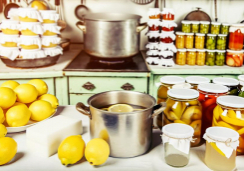6 Best Tips for Perfect Italian Pasta Making
Imagine you're an artist, and each strand of pasta is a stroke of your brush; to achieve the masterpiece that is authentic Italian pasta, you need to start with the right technique.
You've got your apron on and your ingredients lined up, but to elevate your pasta from simply homemade to truly divine, there are a few secrets you ought to know.
From selecting the finest semolina flour to mastering the rolling and cutting of the dough, each step is crucial. You'll need to understand why al dente isn't just a fancy term but the cornerstone of texture, and how the marriage of pasta and sauce goes beyond mere preference to a science of complementary flavors.
As you stand poised to begin your culinary creation, remember that these tips are the difference between a dish that's just okay and one that's talked about for days.
Let's explore these guidelines that can transform your kitchen into the envy of an Italian nonna, with dishes that resonate with authenticity and flavor.
Select Quality Ingredients
When crafting an authentic Italian pasta dish, selecting premium durum wheat pasta is paramount for achieving the quintessential al dente texture and robust flavor profile. Perfect Pasta isn't a happenstance—it's the culmination of using quality ingredients. Prioritize Italian flour, specifically 00 Flour for its finely milled texture, or Semolina Flour, renowned for its high gluten content and golden hue. These are the cornerstones of classic Italian pasta, ensuring a firm bite and a clean canvas for vibrant sauces.
As you navigate the different pasta shapes, bear in mind that each is designed to cradle sauces in its own unique way. Penne rigate embraces thick meat sauces, while angel hair complements a delicate olive oil infusion. The success of your dish hinges on this synergy between pasta and sauce.
To master fresh pasta at home, invest in the best Italian flour and adhere to the pasta's cooking time—this isn't a detail to gloss over. It's the blueprint for texture. And as you boil your chosen pasta, skip the oil. It's a myth that it prevents sticking. Instead, use ample water and stir occasionally to achieve that revered al dente perfection.
Achieve Perfect Dough Consistency
To master the art of pasta, you'll need to select the appropriate flour—00 or semolina typically yield the best results for different pasta types.
Achieving the ideal dough hydration level is critical; start with a tacky, yet not overly sticky, base before incrementally incorporating more flour.
Choosing the Right Flour
Selecting a high-caliber durum wheat flour is critical for crafting pasta dough with impeccable consistency. When aiming for technical precision in pasta Dough Recipes, consider these guidelines:
- Flour Selection: Opt for a premium flour for pasta, like King Arthur, known for its robust gluten structure, which is indispensable for making the dough resilient enough to roll out later.
- Hydration: Initiate with a slightly tacky mixture; add more flour sparingly to avoid a dry and crumbly texture.
- Kneading: Commit to a minimum of 10 minutes of kneading to homogenize and develop the gluten network, ensuring an even al dente bite across various types of pasta.
- Resting: Post-knead, let the dough relax for 30 minutes, which is vital for pliability and ease of shaping.
Ideal Dough Hydration Levels
Aiming for a 50% hydration level in your pasta dough is key to achieving the quintessential consistency for superior pasta-making. When you start by making your homemade pasta, the ideal dough hydration levels are pivotal for that perfect al dente bite. Initially, your dough might feel too dry, but resist the temptation to add water hastily—instead, methodically knead, allowing the flour to fully absorb the moisture.
Employ your stand mixer with a dough hook to expedite the kneading process, ensuring a uniform texture. After the initial mix, let the dough rest; this step is critical for gluten relaxation and even hydration.
When it's time to roll the dough, you'll appreciate the pliability and resilience that proper hydration imparts, making homemade pasta an artisanal craft.
Kneading for Elasticity
Have you ever wondered why chefs insist on kneading pasta dough for no less than 10 minutes? It's not mere tradition; the longer you knead, the more you're developing the dough's elasticity. This is crucial for homemade pasta's perfect bite.
The process is simple but requires a bit of muscle and patience. Here's what you need to do:
- Distribute hydration evenly for a uniform texture.
- Develop gluten networks for that quintessential al dente chew.
- Create a smooth, pliable dough that effortlessly feeds through your pasta machine.
- Enhance resistance to overcooking, ensuring optimal cooking time.
When you make pasta by hand, a food processor can kickstart the mix, but finish with a kneading session draped with a kitchen towel—this is the artisanal touch that elevates good pasta to great.
Master the Rolling Technique
As you transition from dough to delicate sheets, your rolling method is paramount. You'll need to finesse the dough, aiming for a homogenous thickness that ensures al dente perfection post-boil.
Keep a vigilant eye for air pockets and utilize either a well-calibrated pasta machine or a seasoned rolling pin to maintain the integrity of your pasta's texture.
Choosing the Right Flour
To craft pasta with superior texture and nuanced flavor, opt for a high-quality durum wheat flour, the cornerstone of authentic Italian pasta-making. Your homemade pasta will thank you. Here's an essential guide:
- Select a High-Gluten Durum Wheat Flour: It provides the necessary elasticity for your pasta dough, crucial for forming and holding intricate pasta shapes.
- Consistency is Key: Achieve this by gradually incorporating flour into your wet ingredients in a food processor or large bowl until the dough reaches the desired tackiness.
- Resting the Dough: Once kneaded, encase the dough in plastic wrap and let it rest. This is imperative for gluten development, leading to the perfect al dente bite post-cooking.
- Storage Savvy: Store unused flour in an airtight container to maintain its freshness, ensuring premium quality for your next pasta venture, be it delicate lasagna sheets or robust fusilli.
Achieving Ideal Thickness
Once your dough has rested, it's crucial to master the rolling technique, ensuring the pasta's thickness is uniform for optimal texture and even cooking. Gradually adjust your pasta machine, calibrating to the quintessential millimeter-perfect consistency for that coveted pasta al dente.
As you proceed, the dough should exhibit a velvety sheen, devoid of any ragged edges—a telltale sign of impeccable rolling finesse.
Adhere to these tips for making homemade pasta: recipe precision is paramount. If the dough feels too dry, don't hesitate to add water in parsimonious droplets. The goal? A final pasta sheet that clings to the sauce, grabbing onto every flavorful nuance.
Cut Pasta for Desired Dish
Selecting the appropriate pasta cut is crucial to creating a harmonious interplay between your pasta and sauce, ensuring each shape's design characteristics elevate the overall dish. When making homemade pasta, consider the following:
- Sauce Pairing: Choose a pasta shape that complements your sauce. Long, slender noodles like spaghetti are adept at clinging to lighter, oil-based sauces, while ridged pastas like rigatoni embrace heartier, cream-based concoctions.
- Portion Sizing: Gauge the amount of pasta per person; typically, it's about 100 grams of dry pasta. When you cook fresh, this weight will increase slightly due to water absorption.
- Preparation Nuances: Utilize a pasta attachment to achieve uniformity in your cut pasta for the desired dish. Precision in cutting ensures even cooking and optimal texture.
- Cooking Technique: To prevent the pasta from sticking together, add the pasta to a large pot of salted, boiling water, stirring gently. This encourages the pasta to cook evenly and maintain its distinct shape.
Cook to Al Dente Perfection
Achieving al dente pasta, characterized by its firm yet yielding texture, is a testament to your culinary prowess and a cornerstone of Italian gastronomy. It's a delicate balance, a precise point at which the pasta is ready, signaling the epitome of pasta perfection.
To cook the pasta to this revered state, begin when the water starts boiling vigorously. Salt the water generously to infuse the pasta with flavor from the onset. Add the pasta, ensuring not to overload the pot—too much pasta can reduce the temperature and result in uneven cooking. Stir gently to make sure the pasta doesn't stick together.
As the minutes tick by, vigilance is key. Make sure to sample a strand or two a couple of minutes before the package's suggested cooking time; this is critical to capture the quintessential al dente moment. The pasta should offer a slight resistance to the tooth, an assertive bite back, yet shouldn't be hard in the center.
The final act is to drain the pasta promptly, preserving its al dente victory. Remember, the pasta will continue to cook with residual heat, so a timely rescue from the hot water is crucial. Mastery of this technique ensures the pasta clings to the sauce, creating a harmonious dish that pays homage to traditional Italian fare.
Pair With the Right Sauce
Understanding the symbiosis between pasta shapes and their corresponding sauces is crucial for crafting an authentic Italian dining experience. The harmony between pasta and sauce isn't serendipitous but the result of deliberate design and tradition. Here's your blueprint for nailing the perfect pasta-sauce pairings:
- Long, Twirling Pastas: Opt for silkier textures that your spaghetti or fettuccine can wrap around with ease. A classic marinara sauce or a buttery sage sauce complements these shapes, allowing each twirl to carry the right balance of pasta and condimento.
- Ridged Rigatoni: This robust pasta demands a sauce it can grab onto. Its ridges are perfect for holding onto thicker, meatier pasta sauces. Add a rich Bolognese or hearty vegetable ragù and watch the sauce cling to every tube.
- Short and Penne-full: Shorter pasta like penne is designed to absorb and encase sauces. You'll want to pair them with a sauce that's dense enough to get trapped inside each piece, ensuring a burst of flavor with every bite.
- Homemade Match: If you're venturing into homemade pasta, remember that fresh pasta's delicate nature calls for lighter, cream-based or oil-based sauces. They should coat the pasta without overwhelming it, allowing the pasta's texture to shine.
Master these pairings, and you'll elevate your culinary artistry, ensuring each forkful is a testament to the Italian tradition.
Frequently Asked Questions
How Do Italians Make Pasta so Good?
You'll master Italian pasta by perfecting flour selection, precise water ratio, adept kneading technique, allowing dough resting, maintaining rolling consistency, ensuring cut precision, savvy sauce pairing, using fresh ingredients, exploring regional varieties, and honoring family traditions.
What Is the Secret to Perfect Pasta?
Your perfect pasta hinges on flour selection, precise kneading, and dough resting. Master rolling consistency, varied cutting styles, and sauce pairing. Achieve al dente mastery, practice portion control, and prioritize fresh, seasonal ingredients.
How to Cook Perfect Pasta Italian?
For perfect pasta, select the right flour, maintain proper water ratio, and knead thoroughly. Let dough rest, then roll and cut shapes precisely. Pair with a complementary sauce, cook until al dente, and drain well.
What Are 2 Tips in Making Good Pasta?
To make good pasta, you'll need to choose the right flour and control water temperature. Perfect your kneading technique and rest the dough adequately before rolling to the desired thickness.
Conclusion
With these six golden rules, you'll elevate your pasta game to authentic Italian heights.
Start with top-tier semolina or '00' flour for that chef's kiss of quality.
Nail the dough's texture—silky, yet elastic, a testament to your kneading prowess.
Roll with confidence, achieving that paper-thin delicacy.
Cut precisely, mindful of your dish's harmony.
Boil to the coveted al dente, a dance of time and texture.
Lastly, marry pasta and sauce seamlessly, honoring tradition and taste.
Buon appetito!










